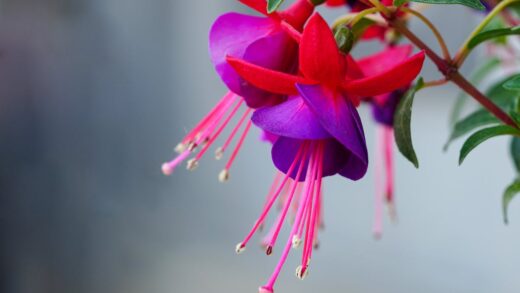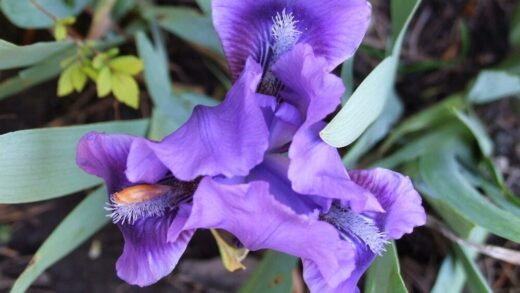The provision of adequate light is one of the most fundamental and non-negotiable requirements for the successful cultivation of gladiolus. These plants are true heliophiles, meaning they are “sun-lovers,” and their entire growth cycle, from the strength of their stems to the quality and quantity of their blooms, is directly tied to the amount of sunlight they receive. Understanding and meeting their high demand for light is essential for any gardener wishing to grow tall, stately gladioli with vibrant, long-lasting flower spikes. Insufficient light is one of the most common reasons for disappointing results, leading to weak plants that fail to live up to their spectacular potential.
Gladiolus plants have evolved to thrive in open, sunny environments, and they require a minimum of six to eight hours of direct, unfiltered sunlight each day to perform at their best. This substantial amount of light energy is necessary to fuel the process of photosynthesis, through which the plant creates the sugars it needs for growth, development, and flowering. A location that provides full sun, particularly during the morning and early afternoon hours, is the ideal site for a gladiolus bed. This ensures the plant has the energy to build strong cellular structures and produce the complex compounds needed for vibrant pigments in the flowers.
When gladioli are grown in conditions with less than the optimal amount of light, several negative consequences become apparent. The most noticeable effect is on the stems, which will become weak, thin, and elongated as they stretch in an attempt to reach for more light—a phenomenon known as etiolation. These spindly stems are often unable to support the weight of the developing flower spikes, causing them to bend, flop over, or even break, especially in wind or rain. This negates the classic upright, stately appearance that is the hallmark of the gladiolus.
Furthermore, a lack of sufficient sunlight directly impacts the plant’s ability to flower. In partially shaded conditions, the plant may produce smaller flower spikes with fewer individual florets. The colors of the flowers may also appear less intense and vibrant than those on plants grown in full sun. In conditions of heavy shade, the plant may fail to produce a flower spike altogether, dedicating all of its limited energy reserves simply to survival and vegetative growth. Therefore, site selection is the most critical decision a gardener makes when planning to grow these sun-loving flowers.
The importance of full sun
The term “full sun” in horticulture generally refers to a location that receives at least six hours of direct sunlight per day, and for gladiolus, this should be considered the absolute minimum for acceptable performance. In reality, these plants will perform even better with eight or more hours of sun. The intensity of the sunlight is also a factor; the strong, direct light of midday is more valuable for photosynthesis than the weaker light of the early morning or late evening. Providing a full-sun environment is the single most important factor in growing strong, productive gladiolus plants.
Sunlight is the direct energy source for photosynthesis. Through this process, the chlorophyll in the plant’s leaves captures light energy and uses it to convert carbon dioxide and water into glucose, a sugar that serves as the plant’s primary fuel. This fuel is used to build all the plant’s tissues, from its roots and leaves to the magnificent flower spike. A plant grown in full sun can photosynthesize at a high rate, producing a surplus of energy that it can invest in creating a tall, thick stem and a large inflorescence packed with numerous, sizable blooms.
In addition to providing energy for growth, full sun exposure also plays a critical role in preventing disease. Many fungal pathogens, such as botrytis and rust, thrive in damp, shady conditions. A location in full sun promotes good air circulation and allows the morning dew on the plant’s foliage to dry off quickly. This rapid drying deprives fungal spores of the moisture they need to germinate and infect the plant tissues. Therefore, a sunny planting site is a key component of a preventative disease management strategy, helping to keep the foliage healthy and functional throughout the growing season.
When planning a garden bed, it is important to consider the position of other plants, buildings, and trees throughout the entire day. A spot that seems sunny in the morning might be cast into shade by a nearby house or a large tree in the afternoon. Observing the path of the sun across the intended planting area for a full day before planting is a wise practice. Ensure that taller companion plants are placed to the north of the gladioli so that they do not cast a shadow over them as the sun moves across the sky.
Symptoms of insufficient light
When gladiolus plants do not receive enough direct sunlight, they exhibit a clear and predictable set of symptoms. Recognizing these signs of light deprivation is crucial for diagnosing the problem and taking corrective action, which usually involves transplanting the corms to a sunnier location in the following season. These symptoms are the plant’s way of communicating that its most basic energy needs are not being met.
The most prominent and classic symptom of insufficient light is etiolation, or the stretching of the plant’s stems. The stems will be noticeably thinner, weaker, and paler in color than those of plants grown in full sun. They will often lean or stretch in the direction of the strongest light source. This structural weakness means the stems are far more likely to bend or break under the weight of the flower spike or in response to wind and rain. Even with staking, the overall appearance of the plant will be lanky and less robust.
Flowering is severely compromised by a lack of light. A plant struggling in a shady location will prioritize survival over reproduction, channeling its limited energy into maintaining its leaves rather than producing flowers. The result is often a complete failure to bloom, or the production of a very small, weak flower spike with only a few, undersized florets. If flowers do form, their color is often muted and lacks the vibrancy and saturation seen in sun-grown specimens. The overall floral display will be sparse and disappointing.
The foliage of a light-deprived gladiolus will also show signs of stress. The leaves may be a lighter shade of green than is typical for the variety and may be thinner and more floppy. Because the plant is weakened by the lack of energy, it also becomes more susceptible to pests and diseases. The combination of weak growth and potentially damp conditions in a shady spot creates an ideal target for fungal pathogens and opportunistic pests. A gladiolus that consistently looks weak, fails to bloom properly, and seems prone to disease is very likely suffering from a lack of sufficient sunlight.
The effect of light on flowering
The quantity and quality of light that a gladiolus plant receives have a direct and profound effect on every aspect of its flowering process. Light influences not only whether the plant will bloom at all, but also the timing of the bloom, the size of the flower spike, the number of florets, and the intensity of their color. The entire reproductive cycle of the plant is powered by the energy it derives from sunlight, making light the primary driver of a successful floral display.
The initiation of the flower spike is a process that requires a significant expenditure of energy from the plant. A gladiolus plant will only commit to this energy-intensive process if it has been able to photosynthesize effectively and build up sufficient energy reserves. In low-light conditions, the plant may remain in a purely vegetative state, producing only leaves, because it lacks the surplus energy required to form a flower. Ample sunlight acts as a crucial trigger, signaling to the plant that it has the resources necessary to successfully produce flowers and, potentially, seeds.
Once a flower spike is initiated, the amount of light continues to influence its development. A plant in full sun will produce a thick, sturdy stalk capable of supporting a large number of buds. It will have the energy to develop more individual florets along the length of the spike, resulting in a fuller, more impressive display. In contrast, a plant in partial shade will produce a thinner stalk with fewer, more widely spaced florets. The overall size and grandeur of the inflorescence are directly proportional to the amount of light energy the plant has been able to capture.
Sunlight is also essential for the development of rich, vibrant flower colors. The pigments that give flowers their beautiful hues, such as anthocyanins and carotenoids, are complex molecules that require significant energy to produce. Plants grown in high-light conditions are able to synthesize these pigments in abundance, resulting in deep, saturated colors. In lower light, the colors may appear washed-out, faded, or dull. For varieties with bi-colored or intricate patterns, the full intensity and clarity of these markings will only be expressed under optimal sun exposure.
Light conditions and plant health
The relationship between light conditions and the overall health of a gladiolus plant extends beyond just photosynthesis and flowering. The amount of sun exposure has significant implications for the plant’s structural integrity, its resistance to disease, and the long-term health and viability of its corm. A sunny environment fosters a robust and resilient plant, while a shady one can lead to a cascade of health problems.
Structurally, the high light levels of a full-sun location encourage the development of compact, sturdy growth. The plant does not need to waste energy on elongating its stems to search for light. Instead, it can invest in creating thick, strong cell walls, resulting in a stout, self-supporting stem and robust, upright leaves. This inherent strength makes the plant less susceptible to physical damage from wind and rain. It also means that the need for artificial staking, while still recommended for the tallest varieties, may be reduced.
From a disease-prevention perspective, a sunny location is invaluable. The intense sunlight and associated warmth and air movement create a microclimate around the plant that is hostile to many common fungal pathogens. The rapid drying of foliage in the morning prevents fungal spores from germinating. The ultraviolet radiation in sunlight can also have a direct sterilizing effect on some pathogens. A plant in a shady, damp location is constantly under a much higher “disease pressure,” making it far more likely to succumb to infections like botrytis, rust, or powdery mildew.
Finally, the amount of sunlight a plant receives during the growing season directly affects the quality of the corm it produces for the following year. After flowering, the leaves continue to photosynthesize, sending energy down to be stored in the developing new corm. A plant that has been in full sun all season will have a large, plump, and energy-rich corm that is well-equipped to survive winter storage and produce a strong plant the next spring. A plant grown in shade will produce a smaller, weaker corm with fewer energy reserves, leading to a decline in performance over successive seasons.


















